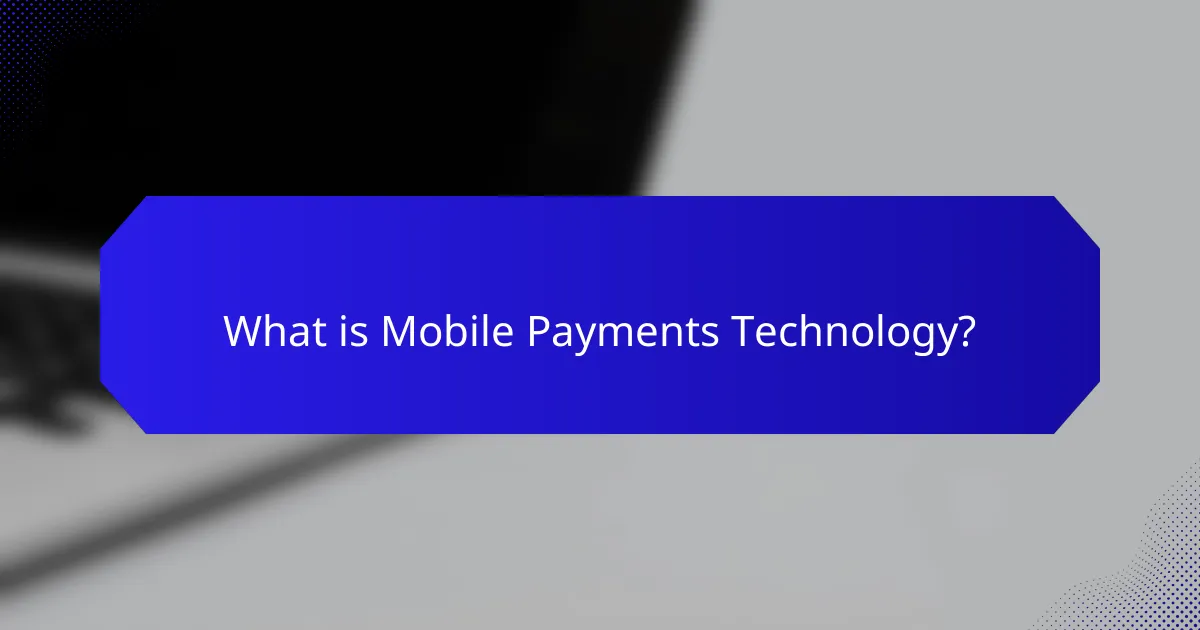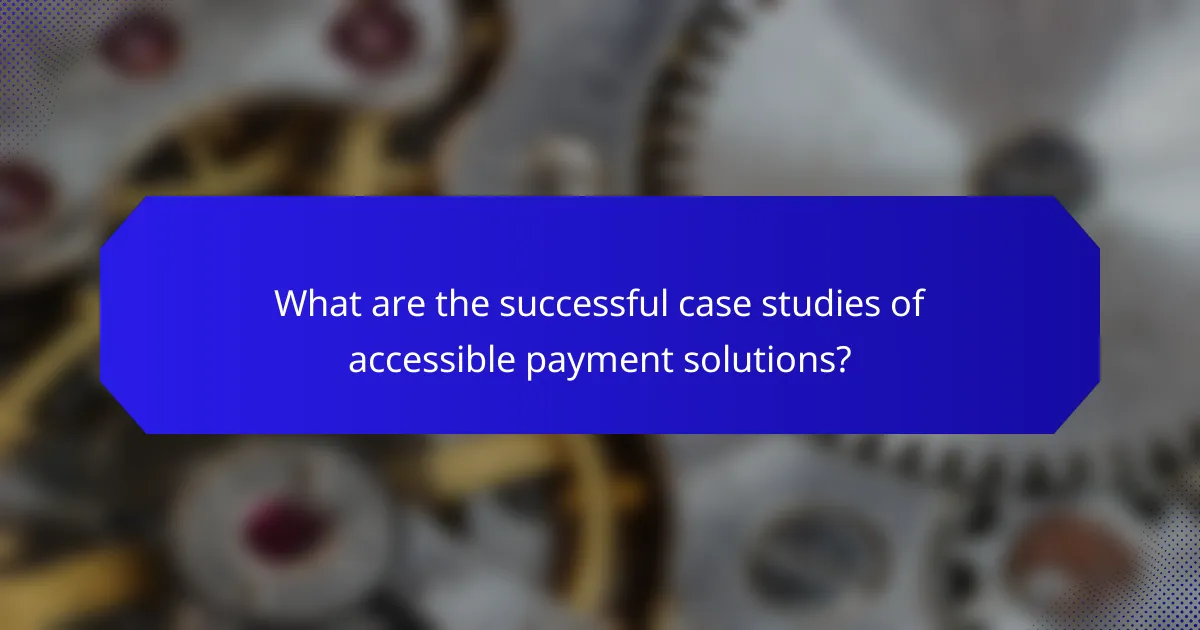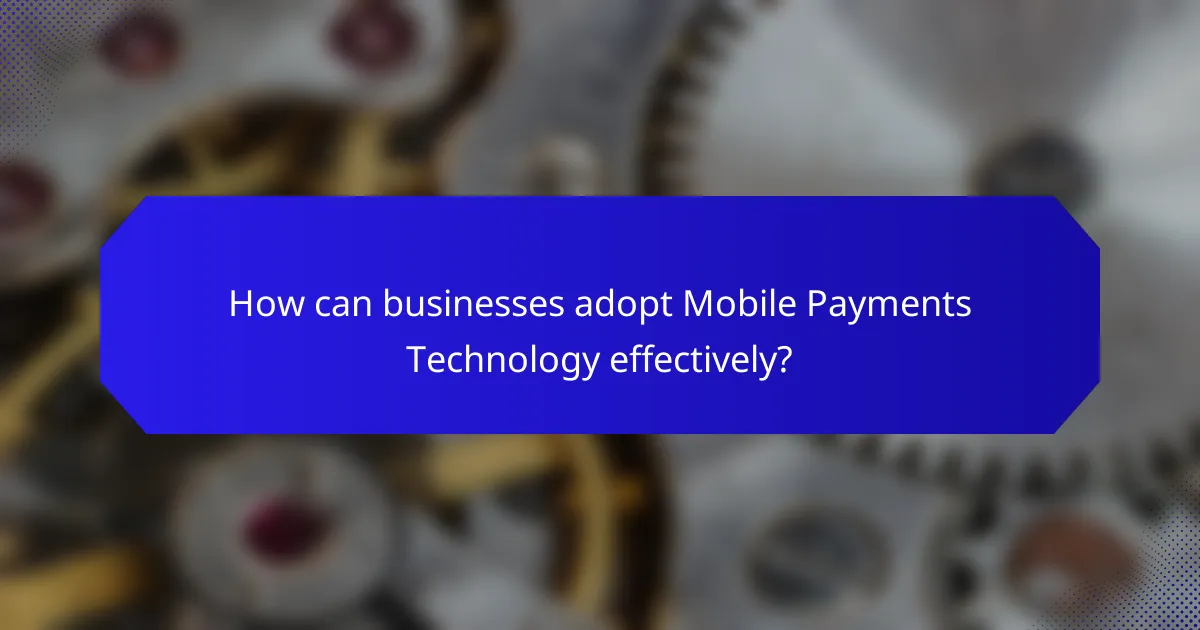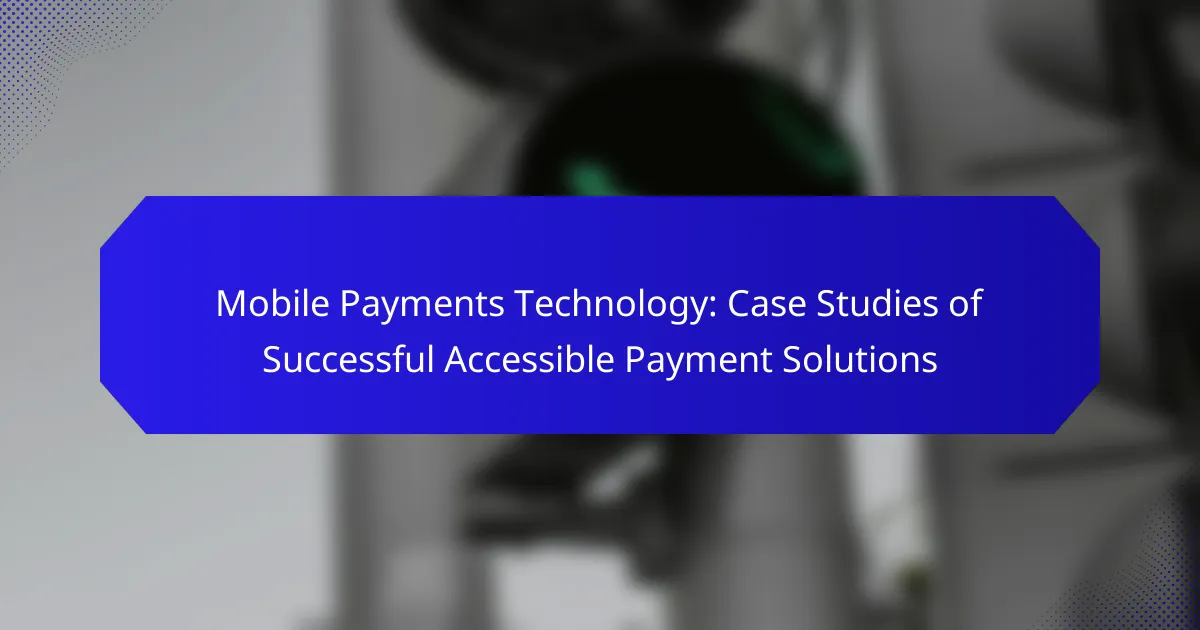Mobile payments technology facilitates financial transactions through mobile devices, enabling users to make payments via smartphones and tablets using methods such as NFC (Near Field Communication) and QR codes. This article explores successful case studies of accessible payment solutions, highlighting platforms like PayPal, Square, and Venmo, which have incorporated user feedback to enhance accessibility for individuals with disabilities. The discussion includes strategies for businesses to effectively adopt mobile payment systems, emphasizing the importance of user-friendly platforms, staff training, and robust security measures. The anticipated growth of mobile payment transactions underscores the shift towards digital payment methods and the necessity for businesses to adapt to consumer preferences for convenience and accessibility.

What is Mobile Payments Technology?
Mobile payments technology enables financial transactions through mobile devices. This technology allows users to make payments via smartphones or tablets. It typically utilizes technologies like NFC (Near Field Communication) or QR codes. Mobile payments can be made through apps or digital wallets. Popular mobile payment systems include Apple Pay, Google Pay, and Samsung Pay. According to Statista, mobile payment transactions are expected to exceed $6.6 trillion by 2022. This growth indicates a significant shift toward digital payment methods. Mobile payments enhance convenience and speed for consumers and businesses alike.
How does Mobile Payments Technology function?
Mobile payments technology functions by enabling transactions through mobile devices. It utilizes wireless communication methods such as NFC (Near Field Communication) and QR codes. Users link their payment methods, like credit cards or bank accounts, to mobile payment apps. When making a purchase, the mobile device communicates with the payment terminal. This communication securely transmits payment information. Encryption protects sensitive data during the transaction process. Many mobile payment solutions also incorporate biometric authentication for added security. Statistics show that mobile payments are projected to reach $12 trillion globally by 2025, highlighting their growing adoption.
What are the key components of Mobile Payments Technology?
The key components of Mobile Payments Technology include a mobile device, payment application, payment gateway, and security protocols. The mobile device serves as the hardware for initiating transactions. The payment application processes the payment and provides a user interface. The payment gateway facilitates communication between the merchant and the financial institution. Security protocols protect sensitive information during transactions. These components work together to enable seamless and secure mobile transactions. Mobile payments are projected to reach $12.06 trillion by 2025, highlighting their growing importance in the financial ecosystem.
How do these components interact to facilitate transactions?
Mobile payments technology components interact by enabling secure, quick transactions between consumers and merchants. The payment gateway connects the consumer’s device to the merchant’s bank. This connection allows for the transmission of payment information. The mobile wallet stores payment credentials securely on the user’s device. This storage enables easy access during transactions. The encryption protocols protect sensitive data during transmission. These protocols ensure that information remains confidential and secure. Finally, the payment processor verifies and authorizes the transaction, completing the payment process. This interaction streamlines the transaction experience for users and merchants alike.
What are the main benefits of Mobile Payments Technology?
Mobile payments technology offers convenience, speed, and enhanced security. Users can complete transactions quickly using their smartphones. This eliminates the need for cash or physical cards. According to a report by Statista, mobile payment users are expected to reach 1.31 billion by 2023. Additionally, mobile payments often incorporate biometric security features. These features, such as fingerprint scanning, reduce the risk of fraud. Businesses benefit from lower transaction costs compared to traditional payment methods. Furthermore, mobile payments can enhance customer experience through loyalty programs and rewards. Overall, mobile payments technology streamlines transactions for both consumers and merchants.
How does Mobile Payments Technology enhance user convenience?
Mobile payments technology enhances user convenience by enabling quick and seamless transactions. Users can make payments using their smartphones without needing cash or cards. This technology supports contactless payments, reducing wait times at checkout. It also allows for easy tracking of expenses through transaction histories. Many mobile payment solutions offer rewards and discounts, further incentivizing usage. According to a study by Statista, the global mobile payment market is expected to reach over $12 trillion by 2024, indicating widespread adoption. Such statistics highlight the growing preference for mobile payments among consumers.
What security measures are integrated into Mobile Payments Technology?
Mobile payments technology integrates several security measures to protect user data and transactions. These measures include encryption, which secures data during transmission. Tokenization replaces sensitive card information with unique identifiers. Multi-factor authentication adds an extra layer of security by requiring additional verification methods. Biometric authentication, such as fingerprint or [censured] recognition, enhances user verification. Secure elements in devices store sensitive data safely. Regular security updates help address vulnerabilities. According to a report by the Federal Reserve, these measures significantly reduce fraud risk in mobile transactions.

What are the successful case studies of accessible payment solutions?
Successful case studies of accessible payment solutions include PayPal, Square, and Venmo. PayPal offers a user-friendly interface that enables easy transactions for individuals with disabilities. Square provides point-of-sale solutions that are designed to be accessible, including features like voice guidance. Venmo allows users to make peer-to-peer payments seamlessly, enhancing accessibility for all users.
These platforms have implemented accessibility features based on user feedback. For instance, PayPal’s commitment to inclusivity has resulted in design adaptations that cater to diverse needs. Square’s accessibility initiatives have been recognized by organizations advocating for people with disabilities. Venmo’s simple design promotes ease of use, which is crucial for accessibility.
Overall, these case studies demonstrate how accessible payment solutions can enhance user experience and promote financial inclusion.
How have specific companies implemented Mobile Payments Technology successfully?
Companies like Starbucks and Apple have successfully implemented mobile payments technology. Starbucks integrated its mobile payment system into its app, allowing customers to order and pay ahead. This feature increased customer engagement and streamlined service. In 2021, Starbucks reported that 26% of its transactions were made through the app.
Apple launched Apple Pay, enabling users to make secure payments using their devices. It utilizes NFC technology for contactless transactions. As of 2023, Apple Pay is accepted at millions of locations worldwide, enhancing convenience for users.
Both companies demonstrate effective use of mobile payments technology through user-friendly applications and strategic partnerships, leading to increased sales and customer loyalty.
What challenges did these companies face during implementation?
Companies faced several challenges during the implementation of mobile payments technology. Technical integration with existing systems was a significant hurdle. Many companies struggled to ensure compatibility with legacy infrastructure. User adoption was another challenge, as customers needed education on new payment methods. Security concerns also emerged, with companies needing to address potential fraud risks. Regulatory compliance posed difficulties, as varying laws affected implementation strategies. Additionally, companies encountered operational issues, such as training staff and managing customer support. These challenges often resulted in delays and increased costs during the implementation phase.
How did they overcome these challenges?
They overcame these challenges by implementing user-friendly interfaces and enhancing security measures. Companies focused on simplifying the payment process. This included reducing the number of steps required to complete a transaction. They also integrated biometric authentication features to increase security. Additionally, extensive user testing helped identify pain points. Feedback from users informed design improvements. Collaborations with financial institutions facilitated better access to banking services. These strategies collectively improved user adoption and satisfaction.
What lessons can be learned from these case studies?
Lessons from these case studies include the importance of user-centric design in mobile payment solutions. Successful implementations prioritize accessibility for diverse user groups. For instance, case studies show that integrating local languages enhances user engagement. Additionally, security features are crucial for building trust among users. Data indicates that seamless user experiences lead to higher adoption rates. Furthermore, partnerships with local businesses can boost acceptance and usage. Ultimately, these case studies illustrate that adaptability to user needs is vital for success.
What strategies contributed to their success?
Successful mobile payment solutions employed several key strategies. They prioritized user experience by ensuring intuitive interfaces. This approach increased customer satisfaction and engagement. They also focused on security features to build trust among users. Implementing strong encryption and fraud detection systems contributed to this trust. Additionally, partnerships with financial institutions expanded their reach. Collaborations with retailers facilitated easier adoption. They utilized data analytics to understand user behavior and preferences. This insight allowed for targeted marketing and improved service offerings. These strategies collectively drove their success in the competitive mobile payments market.
How can these strategies be applied to other businesses?
These strategies can be applied to other businesses by customizing mobile payment solutions to meet specific customer needs. Businesses can analyze their target audience to identify preferred payment methods. This ensures a seamless transaction experience. Integrating user-friendly interfaces enhances customer engagement and satisfaction.
Additionally, leveraging data analytics can help businesses track transaction patterns and preferences. This information can guide marketing and promotional strategies. Collaborating with technology providers can facilitate the implementation of secure and efficient payment systems.
For example, retailers can adopt mobile wallets to streamline checkout processes. Restaurants can use mobile payment apps to improve order accuracy and speed. These applications demonstrate the versatility and effectiveness of mobile payment strategies across various industries.

How can businesses adopt Mobile Payments Technology effectively?
Businesses can adopt mobile payments technology effectively by integrating user-friendly platforms. First, they should choose reliable payment processors that support various mobile wallets. This ensures compatibility with a wide range of devices. Next, businesses must train staff to assist customers with mobile payment options. Training enhances customer experience and builds confidence in using the technology.
Additionally, businesses should promote mobile payment options through marketing campaigns. Highlighting the benefits can increase customer adoption rates. Security is also crucial; implementing robust security measures builds trust among users. According to a study by Statista, 47% of consumers prefer mobile payments due to convenience. This statistic underscores the importance of adopting mobile payments for customer satisfaction.
What are the best practices for implementing Mobile Payments Technology?
The best practices for implementing Mobile Payments Technology include ensuring strong security measures, optimizing user experience, and integrating with existing systems. Strong security prevents fraud and builds consumer trust. Implementing encryption and two-factor authentication are essential components. Optimizing user experience involves simplifying the payment process. A seamless interface increases user satisfaction and retention. Integrating with existing systems is crucial for operational efficiency. Compatibility with various payment methods enhances accessibility. Regularly updating software ensures compliance with evolving standards. Monitoring transaction data helps identify and address potential issues promptly. These practices significantly improve the effectiveness and reliability of mobile payment solutions.
How can businesses ensure accessibility in their payment solutions?
Businesses can ensure accessibility in their payment solutions by implementing user-friendly interfaces. This includes designing applications that are compatible with screen readers. Companies should also provide multiple payment options, such as credit cards, digital wallets, and bank transfers. Incorporating features like voice commands can enhance usability for individuals with disabilities.
Additionally, businesses must conduct regular accessibility audits. These audits can identify barriers within the payment process. Compliance with accessibility standards, such as WCAG, is crucial. Research shows that 15% of the global population lives with some form of disability. Therefore, making payment solutions accessible can significantly expand the customer base and improve user experience.
What common pitfalls should businesses avoid when adopting this technology?
Businesses should avoid underestimating the importance of user experience when adopting mobile payments technology. A poor user interface can lead to customer frustration and abandonment of transactions. Additionally, companies should not neglect security measures. Data breaches can severely damage a brand’s reputation and customer trust.
Another pitfall is failing to stay compliant with regulations. Non-compliance can result in legal penalties and operational disruptions. Businesses should also avoid implementing technology without adequate training for staff. Uninformed employees may struggle to assist customers effectively.
Finally, companies should not overlook the need for ongoing support and updates. Technology evolves rapidly, and staying current is essential for maintaining competitive advantage. According to a report by McKinsey, 60% of businesses that fail to adapt to technological changes struggle to survive in the market.
What future trends should businesses be aware of in Mobile Payments Technology?
Businesses should be aware of several future trends in mobile payments technology. The rise of contactless payments is significant. According to a report by Statista, contactless payment transactions are expected to reach $6 trillion by 2024. Increased adoption of mobile wallets is also notable. A survey by Deloitte found that 60% of consumers prefer using mobile wallets for transactions.
Artificial intelligence will enhance fraud detection in mobile payments. Research from McKinsey indicates that AI can reduce fraud by up to 50%. Blockchain technology is gaining traction for its security benefits. A study by PwC shows that 45% of financial services firms are exploring blockchain solutions.
Integration with Internet of Things (IoT) devices is another trend. A report by Gartner predicts that by 2025, there will be over 25 billion connected devices, facilitating seamless payments. Finally, regulatory changes will shape the mobile payments landscape. The European PSD2 regulation aims to increase competition and innovation in payment services.
How is technology evolving to enhance mobile payment solutions?
Technology is evolving to enhance mobile payment solutions through advancements in security, speed, and user experience. Biometric authentication, such as fingerprint and [censured] recognition, increases security for transactions. Near Field Communication (NFC) technology allows for faster payments by enabling contactless transactions. Blockchain technology provides a decentralized ledger, enhancing transparency and reducing fraud risks. Artificial intelligence is being used to analyze transaction patterns, improving fraud detection. Integration with digital wallets simplifies the payment process for users. According to a report by Statista, mobile payment transaction volume is expected to reach $12 trillion by 2024, demonstrating significant growth in this sector. These advancements collectively contribute to a more secure, efficient, and user-friendly mobile payment landscape.
What role will consumer preferences play in shaping the future of Mobile Payments Technology?
Consumer preferences will significantly influence the future of mobile payments technology. As users demand more convenience, security, and integration, companies will adapt their offerings. A 2021 survey showed that 80% of consumers prefer contactless payments for their speed and ease of use. Additionally, preferences for mobile wallets over traditional banking methods are rising, indicating a shift in consumer behavior. Companies that prioritize user-friendly interfaces and robust security features will likely lead the market. Consumer feedback will drive innovations such as biometric authentication and personalized rewards systems. Ultimately, businesses that align with consumer desires will thrive in the evolving mobile payments landscape.
What are the key takeaways for businesses considering Mobile Payments Technology?
Businesses considering mobile payments technology should prioritize user experience and security. A seamless checkout process enhances customer satisfaction. According to a study by Statista, 52% of consumers prefer mobile payments for their convenience. Security measures, such as encryption and tokenization, are critical to protect sensitive information. Research from the Pew Research Center indicates that 29% of Americans have used mobile payment systems. Businesses must also evaluate integration capabilities with existing systems. Compatibility ensures a smoother transition and reduces operational disruptions. Lastly, monitoring trends in mobile payment adoption helps businesses stay competitive and meet customer expectations.
Mobile payments technology enables financial transactions via mobile devices, utilizing methods like NFC and QR codes for secure payments. The article examines key components, functions, and benefits of mobile payments, highlighting successful case studies such as Starbucks and Apple Pay, which demonstrate effective implementation and user-centric design. It also addresses challenges faced during adoption, strategies for overcoming these obstacles, and future trends shaping the mobile payments landscape. Additionally, the article emphasizes the importance of accessibility, security measures, and consumer preferences in enhancing user experience and promoting financial inclusion.
